HISTORICALTRENDSVERSUSNOW
Following on from the last Farming Update ‘Plus’, the weather and in particular rainfall, has been significantly lower than last year and indeed the 25-year average until June this year. In fact, England on average received an increase of 53% more rain than this time last year. However, because of the dry spring experienced and the far lower water reservoir levels as a result (and a drought as officially declared by the EA in the north of England, and hose pipe bans more recently), the season has felt much drier (Figure 1).
Figure 1. Total rainfall in England in the last three years compared with the 25-year average. Source: MetOffice
In correlation with the very low rainfall, sunshine hours are up, more than the 25-year average and certainly more than last year. Though less so comparatively in June than the previous months of this year (Figure 2).
Figure 2. Total sunshine hours in England in the last three years compared with the 25-year average. Source: MetOffice.
This year's temperatures have exceeded the 25-year average, with each month showing a continued increase compared to the same time period last year (Figure 3). This exemplifies the rate at which summers are warming up in a short period of time Additionally, a recent scientific paper (2025) details how UK heatwaves will become longer and hotter. Whilst the overall chatter about heatwaves becoming more extreme is not anything new, the paper does shed light on the frequencies of them happening. For example, the paper states that the likelihood of extreme temperatures exceeding 40°C in the UK is now 20 times more likely than it was in the 1960s Heatwaves are also likely to extend beyond one month or more in the near future; there wasn’t a specific timeframe given.
Figure 3. Mean temperatures in England in the last three years, compared with the 25year average. Source: MetOffice.
In terms of the month-on-month change, the 25-year average warms up 2.03°C from January to June. This year, in 2025, the month-on-month change is 2.72°C. Although a shift from 2.03 to 2.72 (34%) may initially appear minor, an almost 1°C increase in the warming rate is significant. This has caused crops to grow at a much faster rate than what has been seen before, with harvest already well under way for some growers. Some barley was even harvested in June – previously unheard of. If the rates of temperature increases into the summer months continue in the future, the typical crop growth stages may become condensed, and the growing cycle will shorten. This could have some negative implications, including:
Faster development means less time for photosynthesis which is of particular importance during growth stages such as grain filling for cereal crops, reducing yield potential.
Higher temperatures can impair pollen viability, leading to fewer grains per plant. Compressed growing stages could align with more stages in drought periods, intensifying the stress on the crop. Drought stress was seen much of this year, with early harvest suggesting much shorter crops than before.
On the other hand, rising temperatures and the potential resulting shorter growing periods may offer opportunities, including:
Earlier harvests may enable additional cropping within the year or help avoid pressures after subsequent crop planting dates – though the impact of additional crops within a rotation may have consequences on soil health and overall nutrient demands.
A shorter crop life cycle can reduce the window for pests and diseases to establish, at least until they adapt to temperature changes.
It is important to remain vigilant and review farming operations each year to continue productivity through somewhat unprecedented seasons. Adaptive farm management strategies include:
Adjusting planting dates – not driven by the typical farming calendar, more so what is the situation on the ground such as soil moisture content. For example, specific soil moisture levels for optimal OSR establishment have not been comprehensively researched. However, projects led by Defra (2017) and NIAB TAG (2019) show some evidence that optimal soil volumetric moisture content for the most consistent OSR establishment is between 22-28%.
Switching varieties – for example crop varieties with better rooting properties to remain competitive throughout droughts, as they are becoming more common. Check out one of our recent Agronomy Clubs (2025) which delves into varietal choices in-depth, or listen to our first podcast episode for the low-down from the field at Cereals 2025 on what crop varieties (or mixes) are performing best for next season.
Reviewing irrigation and fertiliser management – for example shorter but more frequent applications to improve efficient uptake by the crop, due to tighter water and nutrition needs before the next crop development stage (or loss from evaporation/high temperatures).
Monitoring pest and diseases (across years as well as in each season).
DROUGHT&EXCESSIVEHEAT–
WHICHISTHEGREATERTHREAT?
You don’t often get one without the other, but which one – drought or temperature –impact crops the most, if either alone? Taking wheat as an example, Table 1 below describes the effects of drought and excessive temperatures on wheat properties. Academic journal findings indicate that drought limits photosynthesis rates (by as much as up to 25%), grain filling, and biomass, while high temperatures reduce yield by decreasing grain number and size and speeding up crop aging. When both factors occur together, crops struggle to cool through transpiration due to insufficient water, worsening stress from heat. Recovery from drought is sometimes possible if rainfall resumes, but recovery from excessive temperatures is difficult.
Table 1. Impacts of drought and high temperatures on wheat crops. Journal sources: Nature Climate Change, Science Direct, BMC Plant Biology.

Research on biostimulants is increasing, providing potential approaches for maintaining crop productivity during adverse growing conditions. While biostimulants cover a broad range of topics, this discussion will focus on their relation to drought and heat stress A recent study investigated the application of two plant hormones—gibberellic and abscisic acids as biostimulants on wheat in pot experiments. These hormones functioned as plant growth regulators, reducing markers of lipid peroxidation and increasing proline and protein content in the crop Lipid peroxidation indicates cellular stress and damage from oxidative stress caused by drought. The study observed that these hormones decreased drought stress by enhancing antioxidant defence mechanisms and maintaining cell membrane stability. These findings highlight the role of such plant hormones in influencing the crop's physiological response to drought, supporting its continued productivity. Research on biostimulants is still at an early stage, and while pot trials are useful for understanding underlying mechanisms, extending research into field trials would clarify their practical applications and potential contributions to developing drought-resilient wheat cultivars.
YIELD PREDICTIONS – CAN WE PREDICT THEFUTURE?
AHDB confirmed that its harvest report is one of the earliest to be published for more than 19 years. This year’s crop, despite the very warm and very dry weather, is looking far better than last year with the harsh frosts and wettest march in 40 years. Early results (whilst based on only a few records so far), suggest that crops might be shorter than usual, yield and grain quality is fair all things considered, with some on the up from previous years (Table 2). Zyatt and Skyfall are recording above the 13.0% protein mark, with some up to 13.4% in the East. Considering these high protein levels, it seems pertinent to remind farmers that some contracts do have a maximum protein % for milling wheats – so do check if you’re getting high protein content!
Table 2. Ceres Early Harvest Winter Crop insights (based on only a small number of results this early in the season, so highly variable).
This year’s accelerated growing season prompted us to review past crop yield and quality alongside climate data for predictive trends. Our analysis showed no strong correlations between yield or quality parameters and variables like sunshine, rainfall, and temperature that could be used to predict future seasons. For example, the figure below shows that over the past nine years, the correlation between total rainfall and group 1 winter wheat protein N % was minimal at an R value of 0.1, indicating almost no relationship – for reference, an R value of 1 suggests a clear and significant correlation. Variability across years is likely to be the cause of these unclear results, but unaccounted factors such as pests and disease also likely influenced these results.
Figure 4. Correlation between annual rainfall and the average protein N % in group 1 winter wheat across the last nine years. Dotted line shows overall trend.
The lack of correlation in climate data makes it difficult to predict future yields, especially with increasingly variable weather patterns. Once we have the full harvest data, we'll analyse whether the dry, hot conditions of 2025 provide additional insights.
REFERENCES
1.Rapidly increasing chance of record UK summer temperatures – Kay – Weather –Wiley Online Library (2025).
2.Agronomy Club – June 2025 – Ceres Research
3.Defra (2017). Project IF0145 – Optimising Soil Conditions for Arable Resilience (OSCAR) Final Report.
4.NIAB TAG (2019). OSR Establishment Trial Report.















